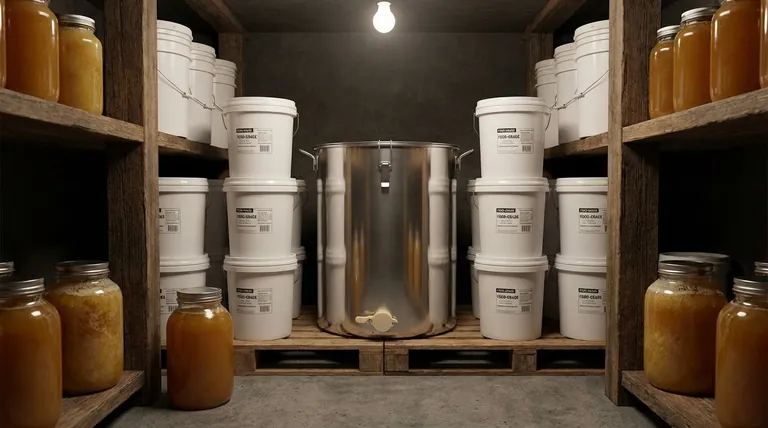To properly store honey before bottling, you must keep it in a tightly sealed, food-grade container in a cool, dark, and dry location. The primary goals are to prevent it from absorbing moisture from the air and to slow the natural process of crystallization. Avoid metal containers, which can oxidize and affect the honey's flavor.
Honey is a remarkably stable food, but its quality between harvest and bottling depends entirely on two factors: preventing moisture absorption and managing temperature. Your storage strategy is simply a way to control these two variables effectively.

The Core Principles of Honey Storage
Understanding why certain conditions are necessary is key to preserving the quality of your harvest. Honey's unique chemical makeup dictates its storage requirements.
Principle 1: Isolate from Air and Moisture
Honey is hygroscopic, meaning it actively draws moisture from the surrounding atmosphere.
When honey's water content rises above approximately 18-20%, naturally occurring yeasts can begin to ferment, spoiling the batch. A tightly sealed lid is non-negotiable.
Principle 2: Manage Temperature and Light
A cool, dark place is the ideal environment for storing honey.
Consistent, cool temperatures (but not refrigeration) significantly slow the natural process of crystallization. Direct sunlight and heat can also degrade the delicate enzymes and aromatic compounds that define your honey's unique character.
Principle 3: Choose the Right Material
The container material has a direct impact on the honey's purity and flavor.
Honey is slightly acidic, which is why it should never be stored in metal containers. The acid can cause the metal to oxidize over time, leaching into the honey and creating off-flavors. Stick to food-grade plastic or glass.
Selecting the Right Bulk Storage Container
The user who asked about not using buckets was advising a consumer, not a producer. For storage before bottling, buckets are often the most practical choice.
Food-Grade Buckets: The Industry Standard
For bulk storage, sealed, food-grade plastic buckets (typically 5-gallon HDPE) are the most common and effective solution.
They are efficient, safe, and protect the honey perfectly when sealed properly. Ensure the bucket is designated as "food-grade" or "food-safe."
Glass Jars for Smaller Batches
If you are dealing with smaller quantities, large glass jars with airtight lids are an excellent alternative. Glass is completely inert and provides a perfect barrier against moisture and air.
A Note on Crystallization in Bulk
Crystallization is a natural process and not a sign of spoilage. If your bulk honey crystallizes, it can be gently warmed before bottling using a bucket warming blanket or by placing it in a warm room for a period of time until it re-liquifies.
Common Pitfalls to Avoid
Simple mistakes can compromise an entire harvest. Being aware of them is the best defense.
Using Non-Food-Grade Containers
Never use old paint buckets, chemical containers, or any plastic not explicitly rated for food contact. They can leach harmful chemicals into your honey.
Storing in the Refrigerator
While it seems logical, refrigeration is not ideal for honey. The cold temperature will dramatically accelerate the crystallization process, turning your liquid honey solid much faster.
Exposing to Heat or Sunlight
Storing buckets near a furnace, in a hot garage, or by a sunny window is a mistake. Heat degrades the quality of the honey and can darken its color over time.
Your Storage Strategy Before Bottling
Choose your method based on your volume and priorities.
- If your primary focus is preserving raw qualities: Store in a consistently cool, dark cellar or pantry to minimize crystallization and protect delicate enzymes.
- If your primary focus is practicality for large volumes: Use sealed, food-grade plastic buckets as the efficient and safe industry standard.
- If your primary focus is long-term, small-batch storage: Choose large, sealed glass jars for the most inert and stable environment possible.
Proper storage ensures the honey you bottle is as perfect as the day it was harvested.
Summary Table:
| Storage Factor | Key Consideration | Ideal Condition |
|---|---|---|
| Container | Must be airtight and food-safe | Food-grade plastic bucket or glass jar |
| Location | Protects from moisture and heat | Cool, dark, and dry place (e.g., pantry) |
| Temperature | Slows crystallization | Consistent, cool temperature (avoid refrigeration) |
| Material | Prevents flavor contamination | Avoid metal; use HDPE plastic or glass |
Preserve the quality of your harvest with the right equipment. Proper storage is the first step, and HONESTBEE supplies commercial apiaries and distributors with the durable, food-grade supplies needed for success. From sealed buckets to warming blankets, our wholesale-focused operations ensure you get professional-grade equipment. Contact our team today to discuss your bulk storage and bottling needs.
Visual Guide

Related Products
- Stainless Steel Honey Storage Tank with Lid for Honey
- Classic Drum Shaped Glass Honey Jar with Airtight Lid
- Hexagonal Glass Honey Jars with Metal Lug Caps Elegant Versatile Packaging
- Inverted Squeezable Honey Jar with No Drip Flip Top Cap for Easy Pouring
- Natural Wood Honey Dipper for Tea Coffee and Desserts
People Also Ask
- Can I store honey in stainless steel? A Guide to Safe, Long-Term Honey Storage
- How long to leave honey to settle before bottling? Achieve Perfect Clarity in 48 Hours
- How long to leave honey in a settling tank? Optimize Your Clarification Process
- How do honeybees generate heat during winter? The Superorganism's Survival Strategy
- How long should honey settle in settling tanks? The 48-Hour Rule for Perfect Clarity



















